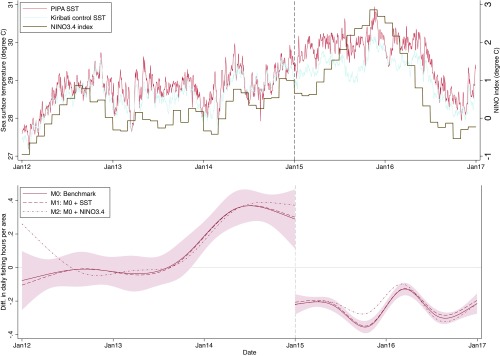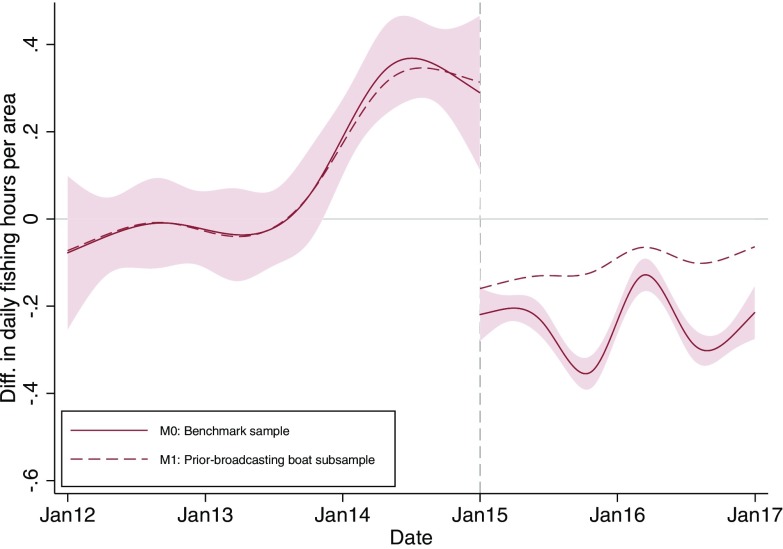A primary goal of McDermott et al. (1) was to stimulate discussion of the “blue paradox” among proponents of marine reserves. We welcome the chance to engage with conservation experts and are grateful for the commentary provided by Hanich et al. (2). However, we are unconvinced by their arguments. Hanich et al. (2) do not offer a substantive critique of our methods or provide data that overturn our findings.
Hanich et al.’s (2) chief criticism relates to the El Niño Southern Oscillation (ENSO), which they claim drove the preclosure surge in fishing activity within the Phoenix Islands Protected Area (PIPA). There are two problems with this argument as it pertains to the findings in McDermott et al. (1). The first is that we already control for the confounding effects of ENSO in our original analysis. For example, model M1 shows that our results are unaffected by the inclusion of region-specific sea-surface temperatures. The same is true if we directly control for a standard ENSO index, as shown in Fig. 1. The second problem is that the 2015/16 El Niño event occurred after PIPA’s closure and thus well after the observed period of anticipatory fishing.
Fig. 1.
(Top) Time-series plots for daily sea-surface temperature (SST) over PIPA and the Kiribati control regions (see figure 2 of ref. 1) and for the monthly NINO3.4 index (5). (Bottom) Estimated restricted cubic spline functions for the difference in daily fishing hours per 1,000 between PIPA and Kiribati control regions, before and after PIPA implementation (see equation 1 of ref. 1). The line shows point estimates and the shaded area shows 90% confidence intervals that are robust to serial correlation and heteroscedasticity of arbitrary form within a 60-d time window. M0 is benchmark model with only a constant term. M1 augments M0 with a quadratic in region-specific SST to M0. M2 augments M0 with region-specific quadratic effects of NINO3.4.
We are surprised by Hanich et al.’s (2) assertion that the non-PIPA part of the Phoenix Islands exclusive economic zone would serve as a valid control region. Our original paper explicitly points out that the proximity to PIPA would engender spillover fishing activity. Such spillover activity would violate the statistical conditions required for recovering unbiased causal estimates (3).
Hanich et al. (2) are concerned by limitations in Automatic Identification System (AIS) data. However, we see little reason why our data—which include approximately 700 unique vessels—would provide a biased measure of fishing activity. This would be true even if environmental factors drove the preclosure surge in PIPA fishing activity as Hanich et al. (2) claim, since vessels respond to the same underlying drivers. Further, we demonstrate that our results are not an artifact of increasing AIS coverage in Fig. 2, which restricts the analysis to vessels that were already broadcasting AIS before the anticipation period starting September 2013.
Fig. 2.
Estimated restricted cubic spline functions for the difference in daily fishing hours per 1,000 between PIPA and Kiribati control regions, before and after PIPA implementation (see equation 1 of ref. 1). M0 shows point estimates from benchmark sample of boats. M1 uses the subsample of boats that were broadcasting AIS before September 1, 2013.
Finally, Hanich et al. (2) argue that our study “relies on behavioral assumptions” that fishermen preemptively increase fishing pressure following the announcement of an impending closure, yet we do not rely on this behavioral assumption. Rather, we test empirically whether it is occurring. We find that it is, and that the effect is very strong, even after controlling for factors that might provide alternative explanations. In our original paper (1), we discussed various potential mechanisms that could rationalize this behavior, both in general and in the specific case of PIPA. We have since been made aware of research that is highly suggestive of a blue paradox in other marine contexts (e.g., ref. 4). Regardless, we agree that more work is needed to gain a better understanding of the underlying behavioral mechanisms. We support all efforts aimed at resolving these questions.
Footnotes
The authors declare no conflict of interest.
References
- 1.McDermott GR, Meng KC, McDonald GG, Costello CJ. The blue paradox: Preemptive overfishing in marine reserves. Proc Natl Acad Sci USA. 2018 doi: 10.1073/pnas.1802862115. [DOI] [PMC free article] [PubMed] [Google Scholar]
- 2.Hanich Q, et al. Unraveling the blue paradox: Incomplete analysis yields incorrect conclusions about Phoenix Islands Protected Area closure. Proc Natl Acad Sci USA. 2018;115:E12122–E12123. doi: 10.1073/pnas.1815600115. [DOI] [PMC free article] [PubMed] [Google Scholar]
- 3.Deschênes O, Meng KC. 2018. Quasi-experimental methods in environmental economics: Opportunities and challenges. Working Paper 24903 (National Bureau of Economic Research, Cambridge, MA)
- 4.Horta e Costa B, et al. Fisher’ behaviour in response to the implementation of a marine protected area. PLoS One. 2013;8:e65057. doi: 10.1371/journal.pone.0065057. [DOI] [PMC free article] [PubMed] [Google Scholar]
- 5.Kaplan A, et al. Analyses of global sea surface temperature 1856–1991. J Geophys Res Oceans. 1998;103:18567–18589. [Google Scholar]




